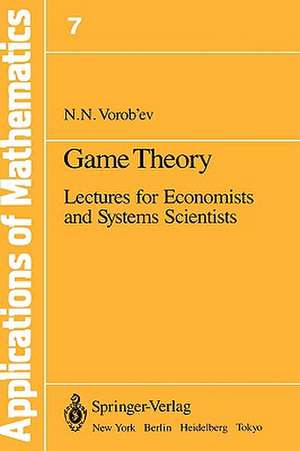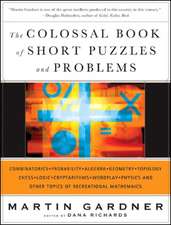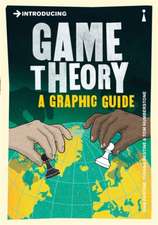Game Theory: Lectures for Economists and Systems Scientists: Stochastic Modelling and Applied Probability, cartea 7
Autor Nikolai N. Vorob'ev Revizuit de S. Kotzen Limba Engleză Hardback – 13 oct 1977
| Toate formatele și edițiile | Preț | Express |
|---|---|---|
| Paperback (1) | 635.31 lei 43-57 zile | |
| Springer – 14 oct 2011 | 635.31 lei 43-57 zile | |
| Hardback (1) | 641.53 lei 43-57 zile | |
| Springer – 13 oct 1977 | 641.53 lei 43-57 zile |
Din seria Stochastic Modelling and Applied Probability
- 17%
 Preț: 464.60 lei
Preț: 464.60 lei - 18%
 Preț: 805.44 lei
Preț: 805.44 lei - 18%
 Preț: 1110.72 lei
Preț: 1110.72 lei - 18%
 Preț: 947.35 lei
Preț: 947.35 lei -
 Preț: 390.84 lei
Preț: 390.84 lei - 18%
 Preț: 952.40 lei
Preț: 952.40 lei - 15%
 Preț: 648.56 lei
Preț: 648.56 lei - 18%
 Preț: 951.91 lei
Preț: 951.91 lei - 15%
 Preț: 637.13 lei
Preț: 637.13 lei - 18%
 Preț: 793.63 lei
Preț: 793.63 lei -
 Preț: 391.02 lei
Preț: 391.02 lei -
 Preț: 401.42 lei
Preț: 401.42 lei - 15%
 Preț: 639.08 lei
Preț: 639.08 lei - 18%
 Preț: 733.33 lei
Preț: 733.33 lei - 18%
 Preț: 785.11 lei
Preț: 785.11 lei - 15%
 Preț: 593.42 lei
Preț: 593.42 lei - 18%
 Preț: 1114.96 lei
Preț: 1114.96 lei - 15%
 Preț: 643.16 lei
Preț: 643.16 lei -
 Preț: 390.63 lei
Preț: 390.63 lei - 15%
 Preț: 645.60 lei
Preț: 645.60 lei - 15%
 Preț: 641.71 lei
Preț: 641.71 lei - 18%
 Preț: 954.62 lei
Preț: 954.62 lei - 15%
 Preț: 645.14 lei
Preț: 645.14 lei - 18%
 Preț: 947.50 lei
Preț: 947.50 lei - 18%
 Preț: 804.96 lei
Preț: 804.96 lei - 15%
 Preț: 644.63 lei
Preț: 644.63 lei - 20%
 Preț: 469.59 lei
Preț: 469.59 lei - 20%
 Preț: 581.39 lei
Preț: 581.39 lei
Preț: 641.53 lei
Preț vechi: 754.74 lei
-15% Nou
Puncte Express: 962
Preț estimativ în valută:
122.77€ • 127.40$ • 102.62£
122.77€ • 127.40$ • 102.62£
Carte tipărită la comandă
Livrare economică 17-31 martie
Preluare comenzi: 021 569.72.76
Specificații
ISBN-13: 9780387902388
ISBN-10: 0387902384
Pagini: 179
Ilustrații: XII, 179 p.
Dimensiuni: 155 x 235 x 13 mm
Greutate: 0.45 kg
Ediția:1977
Editura: Springer
Colecția Springer
Seria Stochastic Modelling and Applied Probability
Locul publicării:New York, NY, United States
ISBN-10: 0387902384
Pagini: 179
Ilustrații: XII, 179 p.
Dimensiuni: 155 x 235 x 13 mm
Greutate: 0.45 kg
Ediția:1977
Editura: Springer
Colecția Springer
Seria Stochastic Modelling and Applied Probability
Locul publicării:New York, NY, United States
Public țintă
ResearchCuprins
1 Matrix games.- 1.1 Definition of a noncooperative game.- 1.2 Admissible situations and the equilibrium situation.- 1.3 Strategic equivalence of games.- 1.4 Antagonistic games.- 1.5 Saddle points.- 1.6 Auxiliary propositions about extrema.- 1.7 Minimax equalities and saddle points.- 1.8 Matrix games.- 1.9 Mixed strategies.- 1.10 A mixed extension of a game.- 1.11 Existence of minimaxes in mixed strategies.- 1.12 Convex sets.- 1.13 The lemma on two alternatives.- 1.14 The minimax theorem.- 1.15 The value of the game and optimal strategies.- 1.16 Three properties of the value of a game.- 1.17 An example: 2×2 games.- 1.18 A graphical solution of 2×n games.- 1.19 A graphical solution of m×2 games.- 1.20 Sufficient criteria for the value of a game and optimal strategies.- 1.21 Domination of strategies.- 1.22 Diagonal games.- 1.23 Sets of optimal strategies in a matrix game.- 1.24 An example: 3×3 games.- 1.25 Symmetric games.- 1.26 Matrix games and linear programming.- 2 Infinite antagonistic games.- 2.1 Introduction and motivation.- 2.2 Situations of ?-equilibrium; ?-saddle points and ?-optimal strategies.- 2.3 ?-optimal strategies and minimaxes.- 2.4 Mixed strategies.- 2.5 Properties of the value of a game and of optimal strategies.- 2.6 The Helly metric.- 2.7 Conditionally compact games.- 2.8 The basic theorem for conditionally compact games.- 2.9 Continuous games on the unit square.- 2.10 Convex functions.- 2.11 Convex games; pure optimal strategies for player II.- 2.12 Convex games; optimal strategies for player I.- 2.13 Strictly convex games.- 2.14 Examples of convex games and their solutions.- 2.15 Market competition.- 2.16 Allocation of production capacities; minimization of the maximal intensity of a production scheme.- 2.17 Allocation of productioncapacities under partial uncertainty.- 3 Noncooperative games.- 3.1 Mixed extensions of noncooperative games.- 3.2 Equilibrium situations.- 3.3 Nash’s theorem.- 3.4 Properties of equilibrium situations.- 3.5 Bi-matrix games.- 3.6 Solutions of bi-matrix games.- 3.7 Almost antagonistic games.- 3.8 Prisoner’s dilemma.- 3.9 The battle of the sexes.- 3.10 Noncooperative games with two pure strategies for each of the players.- 3.11 False advertising.- 3.12 Preservation of ecology.- 4 Cooperative games.- 4.1 Characteristic functions.- 4.2 Characteristic functions of noncooperative games.- 4.3 Properties of characteristic functions for noncooperative games.- 4.4 Imputations and cooperative games.- 4.5 Essential and inessential games.- 4.6 Strategic equivalence of cooperative games.- 4.7 Zero games.- 4.8 The 0-1 reduced form.- 4.9 Classification of cooperative games with a small number of players.- 4.10 Dominance of imputations.- 4.11 The core of a game.- 4.12 The core of a general three-person game.- 4.13 von Neumann-Morgenstern solutions.- 4.14 vN-M solutions for three person constant sum games.- 4.15 vN-M solutions for general three-person cooperative games.- 4.31 Shapley’s vector; axiomatization.- 4.32 Shapley’s vector; existence and determination.- 4.33 Examples of Shapley vectors.- Exercises.- Selected bibliography.

















